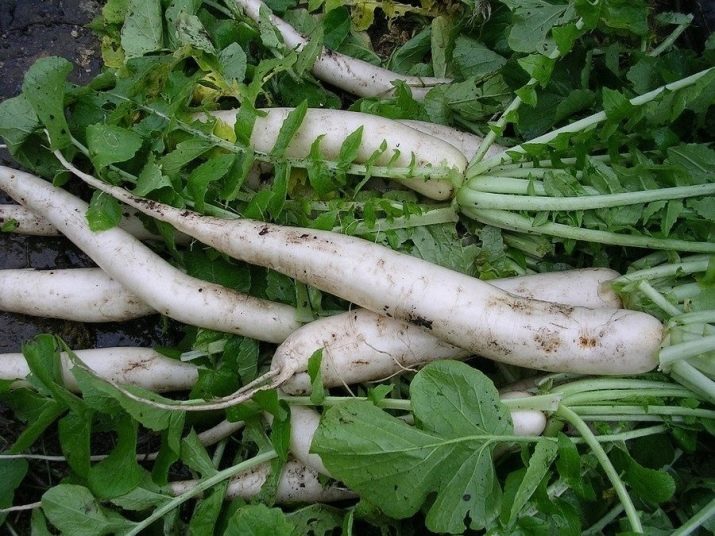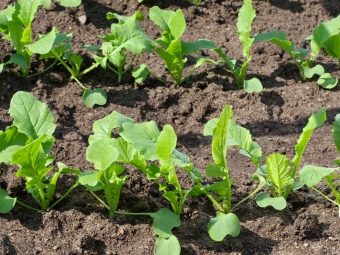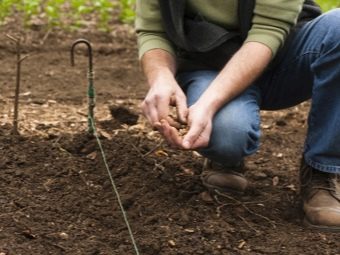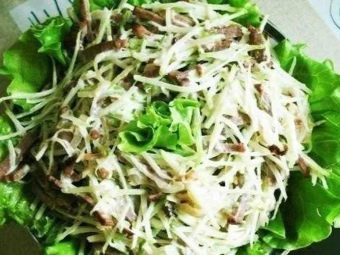Daikon: features, cultivation and application
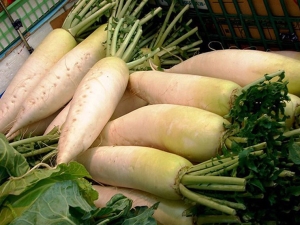
Daikon, he is known worldwide as “Japanese radish”, has recently been very popular with domestic gardeners, and for good reason.
What it is?
In Japan, this root vegetable is included in the diet of local residents almost every day. He settled down here a long time ago, although in fact he has Chinese origin, and arrived in the Land of the Rising Sun in the 6th century from China.
In our country, has long been growing on Sakhalin. Breeders have bred more than 670 varieties suitable for almost all regions and weather conditions. An adult plant can tolerate even low temperatures down to -4-6 degrees. It is undemanding to the soil, although it is necessary to give preference to loose soils. Depending on the variety, the weight of the fruit can reach 5 kg, in length - up to 60 cm. It ripens quickly - in one and a half to two months.
According to its beneficial properties, daikon is not inferior to our usual radish, but it has a more delicate taste - it is juicy and not so vigorous. Fruits are usually white and look like big carrots.
It is eaten in any form - cheese, boiled, pickled, salted. You can eat it at any stage of ripening - from a radish-sized fruit to a half-meter giant. In the process of growth, it does not become harder, its taste does not deteriorate. The tops of the plant can also be used as ordinary greens in salads.
Daikon is a real storehouse of trace elements and vitamins necessary for the body. Rich in carbohydrates, proteins, fiber. When used daikon improves the work of the entire cardiovascular system. This is due to the ability to lower cholesterol, strengthen the walls of blood vessels. Many calcium and potassium salts that are part of the “Japanese radish” affect the removal of toxins from the body, as well as eliminate excess fluid, thereby preventing the formation of edema. It breaks down fats, speeds up metabolism and improves digestion. These properties of vegetables are widely used in the diet.
The high content of vitamins C, B1, B2, PP has an antibacterial effect, helps to strengthen the immune system and fight colds. Iron helps in maintaining normal hemoglobin levels. For pregnant women, it plays an important role in the prevention of anemia.
The iodine content in daikon helps to improve the functioning of the thyroid gland. Selenium helps to prevent the development of cancer. The presence of phosphorus in the composition is indispensable for bone health and normal brain activity.
Through the use of the juice of this plant improves the work of the pancreas, dissolves and removes stones and sand from the organs of the excretory system. Daily inclusion in the diet of Japanese radish has a beneficial effect on the nervous system: it helps reduce aggression, excitability, improves sleep and memory.
Those who struggle with excess weight, this vegetable is suitable because of its low calorie content - only 21 kcal per 100 grams. Fructose in the composition helps to normalize blood sugar levels in patients with diabetes.
When using “Japanese radish” in various face masks, pigment spots are lightened, and the skin is cleared of acne and acne. The antibacterial properties of the root helps to heal wounds.
As with any product, daikon, in addition to the benefits, there are contraindications. Do not use this plant for people with diseases of the esophagus, stomach, intestines and duodenum, liver and kidneys. At least, before this you need to consult with your doctor.
Harm can be inflicted if you do not comply with the measure. Even in a healthy person, excessive consumption of “Japanese radish” can cause bloating, a feeling of heaviness and irritation of the gastric mucosa.
Sorta
For gardeners who decide to start growing daikon, an incredible amount of different varieties is available. When choosing, you should take into account the climatic conditions, soil properties and other points. Proper selection of the desired plant will already provide half the success.
By the duration of ripening, daikon fruits are divided into early-ripening, mid-ripening and late-ripening varieties.
Early maturing
The first root crops from this category can be collected in 35-50 days.
- Sasha - resistant to frost and quickly ripening variety, good for planting in central Russia, including the Moscow region and the Urals. Already in 35-45 days, a vegetable weighing 200-400 grams and 10-11 cm in diameter is ripening. The fruits are white, of a beautiful rounded shape, with thin skin and juicy pulp. This variety can be planted in heavy solid soil. Used for diet and baby food.
- "Snow White" ripens in about 50 days, the fruits of elongated shape weigh up to 300 grams, have a light green color of the skin and snow-white juicy flesh. High-yielding variety that is stored for a long time and does not lose its useful properties for up to 5 months. There is a nice little speck in the taste.
- "Prince of Denmark" - Another early daikon. Looks like a long radish. The peel is red, the fruit is white inside, about 10 cm in length, sometimes up to 25 cm. Due to disease resistance and tsvetushnosti gives a good yield.
- "Sugar Rose" - a beautiful variety of pink. Matures quickly and has high yields. Vegetable round shape, an average of 10 cm in diameter. Not bad tolerate low temperatures. And thanks to the appearance will be the decoration of any table.
Mid-season
It will be possible to harvest the useful yield of these plants in 60-80 days after planting in the ground.
- "Dubinushka" - this vegetable can be harvested in 55 days, so it will be suitable for Siberia with its short summer. The white fruits of elongated cylindrical shape resemble a club. By weight, the vegetable reaches 0.5-2 kilograms. Possesses dense pulp and sweetish not bitter taste. It tolerates long storage.
- "The Dragon" - root crops of this grade ripen in 60-70 days after emergence of shoots. Their weight is an average of 900 grams. They have a cylindrical shape, in diameter of 6-8 cm. The taste is refreshing, sweetish, without sharpness. "Dragon" is perfect for long-term storage and even in winter it retains valuable vitamins and trace elements.
- "Pink glitter" ripen in 60-70 days. A distinctive feature of this variety is bright pink flesh. Fruits have a rounded, slightly oblong shape, a diameter of about 10 cm, can be up to 20 cm in length. Cold-resistant. The yield is low, but this is compensated by the great taste and aesthetically attractive appearance.
- "Elephant Fang" fully matures in 70-90 days. Fruits are elongated, in diameter 7-8 cm and up to 25 cm in length. Their weight is 500-600 grams. A feature of this variety is resistance to heat and drought. High yield also makes it popular.
- "The Emperor" ripens in 60-75 days. Bright red fruits are like icicles. The high-yielding variety is also distinguished by resistance to diseases and pests such as the cruciferous flea. On loose earth, fruits can reach 60 cm in length and weigh 500-600 grams. Inside the vegetable is white.
- "Red heart" manages to fully mature in 60-70 days. This is another disease-resistant variety. It has an interesting appearance - rounded shape, green skin and red flesh. It can grow up to 1 kilogram and up to 40 cm in diameter.
Late-ripening
Plants with a long ripening period for 90-200 days do not have time to fully ripen in middle latitudes. They compensate for their slow growth with record sizes.
"Japanese Long" - this type of daikon reaches weight up to 3 kg. High-yielding, resistant to leveraging and disease. Suitable for long term storage. Tastes are excellent - the vegetable is juicy, moderately spicy.
Classification of varieties of daikon can be carried out on the preferred type of soil.
- Variety "Minovase" grows well on light soils. Refers to mid-season high-yielding varieties. Fruits weighing 1.5 kg and 40-50 cm long are fully matured in 60-70 days.The variety is resistant to diseases, tolerates high temperatures and drought well, but low ones slow down and stop the ripening process - the plant leaves early in the arrow. The root crop has a cylindrical shape, thin skin, dense texture and sweetish taste.
- Variety "Nerima" It was developed on volcanic soils, so this plant has good fruit in loose, light earth. Belongs to mid-season varieties, matures in 70-100 days. Mature fruit reaches a length of 70 cm, about 10 cm in diameter, and on? rises above the ground. It has a white and green color and a smooth surface. In its raw form it is good in salads. Salts from it also have excellent taste.
- Shogoin It was developed especially for heavy clay soils. Fruits are round and up to 20 cm in diameter ripen in 70-100 days. They have a juicy sweet taste. It is advisable to eat it fresh.
- "Miyashige" preferably planted on loamy soils. Although on other soils, it bears fruit quite well. These vegetables take off for 60-80 days. Adult root has a length of 50 cm and a thickness of about 9 cm. The shape is cylindrical, the skin is light green. You can eat fresh and pickled. And from the cooked fruit "Miyasyge" prepare delicious savory dishes.
- "Siroagari" also preferable to plant in heavy clay soils. Full maturation occurs in 55-60 days. Root crops go into the ground only a third, it facilitates the care and harvest. They have a cylindrical shape with a rounded end, reach a length of 30 cm with a thickness of 7 cm - a good yield for such a soil. Consume fresh and added to salads.
- "Kameido" prefers sandy soils. Fruits are conical in shape, small. To its size of 15 cm grow in 60-70 days. The flesh is white, slightly sharp. The cuttings and leaves of this variety are particularly juicy, they can be used to make salads
- "Ninengo" - the most versatile variety that feels great on any soil. Vegetation period - 65-75 days. Vegetable white color, elongated cylindrical shape, almost completely hidden in the ground. The length is about 60 cm with a diameter of 6 cm. The taste is distinguished by a pleasant wit. It is best to eat the fruit fresh.
In addition to these generally accepted classifications, all varieties are also divided into groups according to their growing seasons.
- Haru (spring). This group is most popular among summer residents for growing in mid-latitudes. In milder climatic conditions, they can be planted all year round. Stewing for this category is not typical. If the planting is made at the beginning of spring, then in May the first harvest can be gathered. The June planting will bear fruit in August-September. In warm regions for the third time it is possible to land for the winter, and by spring the daikon will mature.
- Hatsu (summer). This group includes all early ripe varieties. Landing in the ground is made in May-June, the plant is resistant to heat. Ripened roots can be harvested after 50-60 days. It is recommended to consume fresh and in salads.
- Aki (autumn). This is a group of mid-season and late-ripening varieties. Planting is carried out in August, and in the fall vegetables can be collected. The varieties of this group have high yields, and the fruits reach record sizes.
- Fuy (winter). A small group of varieties, not in demand in our latitudes. It is possible to grow them only in warm climatic conditions, since these plants do not tolerate frosts at all.
Planting dates
In addition to the correct selection of varieties of "Japanese radish", it is important not to lose while with the time of sowing and planting in the ground.
Despite the cold-resistant properties of this culture, frost for her young shoots can be disastrous. It is better that the temperature does not fall below +10 degrees. But too high temperature will prevent the normal formation of the root, and a long daylight hours will lead to the fact that the plant blooms and goes to the arrow. In this case, normal fruits will not have time to form.
Therefore, the best time for our climatic conditions is planting in early spring or in the second half of summer.
In early spring, seeds for seedlings are most often sown beforehand. With this method, it is better to choose varieties of a rounded or slightly elongated shape in order to reduce the likelihood of damage to the long spine during transplantation. Further landing in the ground is made later - about a month later, when there will be at least two leaves on the shoots. This method helps to avoid their hypothermia. Domestic gardeners for this also use various shelters.
Seeding daikon in early spring will allow harvesting in June. For storage in the fresh winter, this crop will not work, but in the summer it will be possible to eat healthy fruits.
More popular and less troublesome landing in the second half of summer. In the Urals, in the Moscow region and the regions of the middle band this is July (in the more southern regions even the end of August and the beginning of autumn) frost in July is unlikely, and a cooler temperature in September will impede flowering and the root crop will have time to fully ripen. In addition, some cultures by this time have already been collected and a place can be cleared at the dacha.
The most suitable time depends on the region, weather conditions. It is recommended to sow after rains on wet soil, so dates can shift. If you plant a daikon in July, you will be able to collect beautiful juicy fruits in early autumn. And since some varieties can be stored for up to 5 months, this is the best option for stocks for the winter.
In the fall, planting daikon is possible only in the southern regions with warm winters and in the most favorable areas where the culture will not be threatened by wind and frost.
Landing
It should be noted that most varieties of daikon are quite large. Consequently, in addition to good fertile soil, they need a vast area.
The optimal distance is between the rows of 65-70 cm, and adjacent plants in a row can be located 20-25 cm apart. Growing in closer conditions will only lead to shredding the crop to the size of radish. Root vegetables weighing under a kilogram and more in this case will not work.
In the event that not every seed rises, it is recommended to place 2-3 seeds in one well. After germination, the excess and weaker need to be removed - carefully cut off at ground level. It is not necessary to pull, so as not to damage the next necessary root.
For better illumination and for the convenience of caring for a plant, it is preferable to grow it in narrow single and double row beds, rather than plant it in a solid area. In this case, each bed in width will be about 1.5 meters. It is still convenient and, if necessary, to hide the culture from the weather.
In the absence of large vacant areas, a good option is to plant on small plots that have been freed after harvesting other crops.
The ideal option would be early varieties of potatoes, carrots, onions, legumes, greens. But after cruciferous relatives (cabbage, radish) plant daikon, on the contrary, is not recommended.
Although "Japanese radish" and unpretentious to the soil and can adapt to any type, it is still better to choose lighter and friable areas. You should also take care of the environment - it should be neutral or slightly acidic. To reduce the acidity, you can use lime.
If some areas were treated with mineral and organic fertilizers, then this is the best option. You can also use the universal mixture for vegetables.
How to prepare seeds
Before planting, planting material must be soaked and hardened. To prevent diseases, it is also recommended to treat the seeds with a special prophylactic solution. You need to soak for 35 hours in the day in warm water (you can use a thermos), or pour hot 50-degree water for half an hour and then hold it in cold water for a couple of minutes.
Next, wrap the grain with a damp cloth and place in the refrigerator for a day. After hardening, you can immediately plant them on seedlings or in open ground.
When sowing seedlings for planting should be washed and disinfected with potassium permanganate. Their depth should be not less than 10 cm. Peat tablets and peat pots can be used. The soil should be moist and light.
Grains are placed at a depth of 2 centimeters, 2-3 pieces per hole. Top need to sprinkle them with loose earth and slightly sprinkle with water. Pots must be covered with plastic wrap or glass. Put in a warm place until the seeds have risen.
About a week after the emergence of shoots of capacity, you need to move to a well-lit place and remove the cover. When the shoots will have the first two leaves, the seedlings need to thin out, cutting off the adjacent weaker shoots. To better form the root system, daylight hours for seedlings should not exceed 13 hours.
If the land on the site is dry, then before digging and the formation of the beds it should be well moistened. Further, on the ground soil, rows are laid out and poured with water. It will help the seedlings to settle down, and the grains will rise faster. The distance between the seeds is selected depending on the type and size of the root. In one well to a depth of about 2 cm is placed 2-3 grains.
After planting, the surface should be sprinkled with water and sprinkled with a small layer of loose earth, humus and peat. This will create favorable conditions for the development of daikon. In cold weather, beds are recommended to be covered with a film, and if they are too hot, you can cover them with a breathable material such as lutrasil or agryl.
The timing of germination may be different, but usually the first shoots appear for 5-7 days. During this period, you can use humus to feed. If the plants have risen too often, then it is necessary to thin them out.
Care
Although daikon and unpretentious culture, but the implementation of the simplest measures of care will only increase its yield, as well as affect the quality of the fruits themselves. During the entire period of maturation, the plant needs regular watering, weeding, and protection from pests and diseases. Feeding also will not be superfluous.
"Japanese radish" grows well only on wet soils, so throughout the growing season the soil should not dry out. Drought adversely affects the fertility of the crop. The plant can go to the arrow, the root itself will crack, and its flesh will become hard and bitter. But it is necessary to comply with the measure - puddles and excess moisture can trigger the development of fungal diseases.
Immediately after the appearance of the first shoots, the plant must be watered. Further watering is recommended twice a week. If it rains, then you do not need to moisten the soil. But in hot sunny weather you need to water the land every day. At the same time, in order to retain moisture, the soil between the rows can be slightly mulched with peat or humus.
Since daikon prefers lighter types of soil, it is necessary to loosen the earth for it every week. At the same time, weeding of the plant from weeds is carried out. It is necessary to get rid of them, as they will take away all the useful substances from the soil, oppress daikon and create an unnecessary shadow. In addition, weeds can infect a crop with dangerous diseases.
Many varieties of daikon strongly protrude above the ground, so with the growth of its root, it is also desirable to spud it. Thanks to this, the fruits will only be juicier and tastier.
If daikon is grown on fertile, cultivated soil, then additional fertilizer is not necessary. Otherwise, and especially if the plant looks depressed, the “Japanese radish” needs feeding. And it should be not only organic mixtures, but also mineral ones.
Wood ash can fertilize the soil after the appearance of the first 4-5 leaves.This should be done before watering, sprinkling directly on the sprouted greens.
In the same period, the soil between the rows can also be sprinkled with a nutrient mixture, and next to each shoot to make a teaspoon anofoski.
Approximately in the middle of the term for feeding you can use the “Magbor”. This mixture of magnesium and boron will make the vegetable more sweet and tasty, as well as contribute to longer storage.
Daikon pests, like his fellows, a lot - flea, aphid, flies, snails and many others. The main enemy can be considered cruciferous flea. She eats the very first shoots and leaves. To prevent its occurrence, it is recommended to sprinkle the beds with tobacco dust and ash. During the entire period, you need to repeat it several times. The use of shelters also helps well - in such a case, the flea and other pests cannot reach the plant. If the cruciferous flea has already been wound up and has caused damage, then the drug Aktofit is used one-time.
Damage from a cabbage fly is no less serious. Its larvae damage the root itself, making tunnels in it. From this vegetable becomes defenseless against infections. Eating it is impossible. These pests are able to destroy the entire crop. To combat them, you can from time to time sprinkle the plants with a solution of hot pepper, tobacco dust and ash.
Slugs also actively besiege the beds, while eating both the leaves and the daikon fruit. To snails could not reach the plant, the soil between the rows sprinkled with superphosphate powder. And along the perimeter of the beds you can make a groove and pour wood ash there.
The pest control principle can also be used for pest control. For the "Japanese radish" best neighbor - onions. His phytoncides distilled cruciferous flea and other insects. And if you plant marigolds next to the beds, they will scare away many other insects with their scent, including the cabbage fly.
Diseases do not often affect the harvest of "Japanese radish", but in case of infection they carry no less danger. The described procedure of planting soil and ash with ashes helps in the prevention of diseases.
Fungal diseases can develop due to constant humidity. To reduce the risk, the soil and seeds are decontaminated before planting. And for good circulation of fresh air, it is imperative to get rid of weeds. Water should not stagnate on the surface. This can also lead to the development of mucous bacteriosis.
At the slightest signs of fungus, the plants should be treated with Binoram and Planriz. It is better to remove the most affected plants immediately.
Storage rules
In order to keep the roots longer harvesting is desirable to do in dry weather. From dry soil, fruit will be easier to remove without damage. It must be remembered that in depth they can go up to half a meter, so before extracting them, you need to slightly dig up the ground with a pitchfork. Then take the tops and, slightly shaking, pull the fruit out of the ground.
If there are lumps of soil on its surface, then you do not need to touch them - you can damage the thin skin of the vegetable and it will not be stored for a long time. When the plant is dried in the air the remnants of the earth will be sprinkled.
After removing daikon from the soil, the tops must be cut, leaving a cutting about 2 cm. Uncut leaves will quickly make the vegetable flabby. If during harvesting some fruits were damaged, it is better to eat them immediately.
It is very important to have time to harvest before frost. Frozen vegetables will start to deteriorate quickly and will not be suitable for winter storage. Therefore, if there is such a threat, it is better to shelter the beds in time.
The optimal storage temperature of "Japanese radish" is 0. +5 degrees. Fruits should not have the slightest damage, including cabbage fly. Winter storage in the cellar or basement is recommended to be carried out in wooden boxes.
Lay the fruit in the box to be at a distance from each other, and each layer to wake up with wet sand or clay. During storage, periodically you need to check the daikon in order to have time to remove the spoiled vegetables.
If storage is possible only in the refrigerator, then they must be placed in breathable bags. Subject to all the rules, juicy and healthy fruits will delight for 3-5 months.
Cooking recipes
The cooks of the whole world Daikon have long been fond of the wide range of applications and excellent taste. Dishes are succulent and healthy. Moreover, this vegetable can be cooked even for children.
It is good to eat it fresh in salads, salt for winter, stew and cook. Light vegetable dishes, more nutritious meat and seafood, as well as all kinds of snacks and main dishes - the widest range of white radish.
In Japan, daikon is also dried. And at home - in China, it is used as a filling for baking.
Salads with fresh daikon should please supporters of proper nutrition and millions of slimming.
In just a few minutes you can cook the fastest version of the salad - mix grated carrots and white radish and fill with your favorite sauce and seasonings. Mostly for salads with daikon, olive or refined sunflower oil, classic soy sauce without additives, and, of course, mayonnaise, popular in our country, are suitable.
For meat salad it is recommended to use turkey fillet or beef, but another type of meat will do. Daikon and boiled fillet is taken in proportions of 3: 1. Both products are cut into strips and mixed with toasted onions.
Unusual light salad made from white radish with walnuts. 0.5 kg of grated daikon is mixed with one carrot, walnut kernels dried on a pan. Garlic, cilantro, salt and juice of half a lemon are added.
Juicy and tasty salad turns out with green apples. 200 g of daikon, carrot and apple are rubbed and dressed with mayonnaise, salted and decorated with greens.
For a very useful salad with kelp (seaweed) will need more boiled mussels and shrimp. 0.3 kg of fresh kelp, without additives, must be thoroughly washed from the sand. After that, it is filled with marinade (a glass of water, 2 tsp. Of vinegar) and left in a cool place for a day. After that, the kelp should be washed again, add to it a handful of boiled mussels and shrimp, grated daikon on a small grater and pour plenty of fresh lemon juice.
For a pleasant sharpness and piquancy, you can add rings of red Crimean onion to this salad. Salt, mix and healthy salad is ready.
Marinated Daikon is an extraordinary crispy snack that has a delicious aroma and savory taste. It can be eaten as an independent dish, and you can add pickled vegetable as a component of many dishes. This recipe is suitable for long-term storage for the winter.
Half a kilo of daikon must be washed and cleaned from the skin, can be cut into thin circles or sticks. The chopped vegetable is placed in clean, stearised dishes.
In a separate bowl, mix half a glass of water with a spoonful of saffron. After adding 50 ml of rice vinegar, 5 teaspoons of salt and sugar, mix everything well again and pour the prepared daikon in the marinade. Then close well and move to a warm place for a week. The snack is ready. For further storage, the finished product should be refrigerated.
Daikon Korean-style appetizer is good as a side dish for meat and fish. And often it is added to sandwiches - it turns out nourishing, healthy and tasty product.
To begin with, the main ingredient (600 g of fresh vegetable) needs to be cleaned up and rinsed thoroughly under running water. After that, daikon is rubbed on a large grater. Ideal - a special grater for carrots in Korean. Garlic cloves (3-4 things) must also be peeled from the husk and crushed in the press before the formation of gruel.
One spoon of ground coriander is mixed with salt and red pepper (½ tsp) and added to the container with daikon.
For the preparation of refills used onions, one head is enough. It needs to be well cleaned, finely cut and fry in a skillet with refined oil (50 ml). Because of this, it will get a special smell. Then you need to drain the oil and pour it on the daikon.
After that, everything is thoroughly mixed. Daikon Korean ready.
Laghman with daikon is an excellent main course. For its preparation will need:
- 1 kg of beef;
- 300 grams of white radish;
- 2 medium onions;
- 2 medium carrots;
- 300 grams of sweet red pepper;
- 3 garlic cloves;
- 300 grams of tomatoes;
- 300 grams of noodles for lagman;
- coriander, curry, sugar, salt - to taste;
- 4-5 green onions feathers;
- 30 ml of refined vegetable oil; liter of water.
Broth is prepared separately. It will require:
- 1 onion;
- 1 carrot;
- 2 bay leaves;
- 3 garlic cloves;
- A few sprigs of dill and whole black peppercorns - to taste.
First you need to do the broth. To do this, meat and vegetables must be washed, cleaned and together with spices sent into the water. After the broth begins to boil, you need to remove scale, close the dishes with a lid, turn down the heat and simmer the contents for 1.5-2 hours.
While the broth and meat are being prepared, there is time to prepare the remaining ingredients for the lagman. Peeled carrots and onions should be cut into rings and fry in butter for a couple of minutes in a pan or in a thick-walled saucepan. Then add garlic, daikon straw and paprika. Fry everything together need another 2-3 minutes. Tomatoes must be peeled, cut into small pieces and add to the rest of the ingredients along with the spices.
Next, cook the noodles. Add chopped green onions and broth to vegetables. The consistency can be adjusted by yourself. After that, put the noodles and chopped beef to the already almost ready vegetables, simmer a little more - until the noodles are ready.
Although daikon is mainly used as a food product, it is worth noting other areas of its use.
At home, for example, it is actively used in medicine and cosmetology. Daikon juice during a daily diet can contribute to faster weight loss. It is recommended to drink at night about 100 ml of fresh juice. To get it daikon rubbed and wrung out. To soften the taste, you can add a little apple or carrot juice.
For colds, daikon juice is mixed with honey and taken 50 times a day, 3 times a day. It helps in the elimination of harmful viruses, dilution and sputum withdrawal.
Fresh juice (1 tbsp. Spoon), mixed with a small amount of sugar, helps in the fight against arrhythmia.
With purulent wounds, a compress from the pulp is applied to the affected place and the lotion is changed every 2-3 hours.
The green part of the vegetable, tops, is used in the treatment of constipation. Spoon the tops poured boiling water and leave for 40 minutes. Then filter, cool and take three times a day after meals.
For the prevention and control of anemia, it is recommended to bake grated daikon, carrots and beets in the oven. Take a spoon before a meal.
Daikon is also used for cosmetic purposes. It has an antibacterial and antifungal effect and a beneficial effect on the skin, hair and nails. With it you can lighten pigment spots and freckles. To combat acne and acne, make a mask of daikon, mixing it with aloe juice, regular cream or sour cream.
You can wash your face with fresh juice - the skin will look younger, fresher and more toned.
Before using folk recipes, you should consult with a doctor and specialized specialists.
How to grow daikon, see below in the video.







